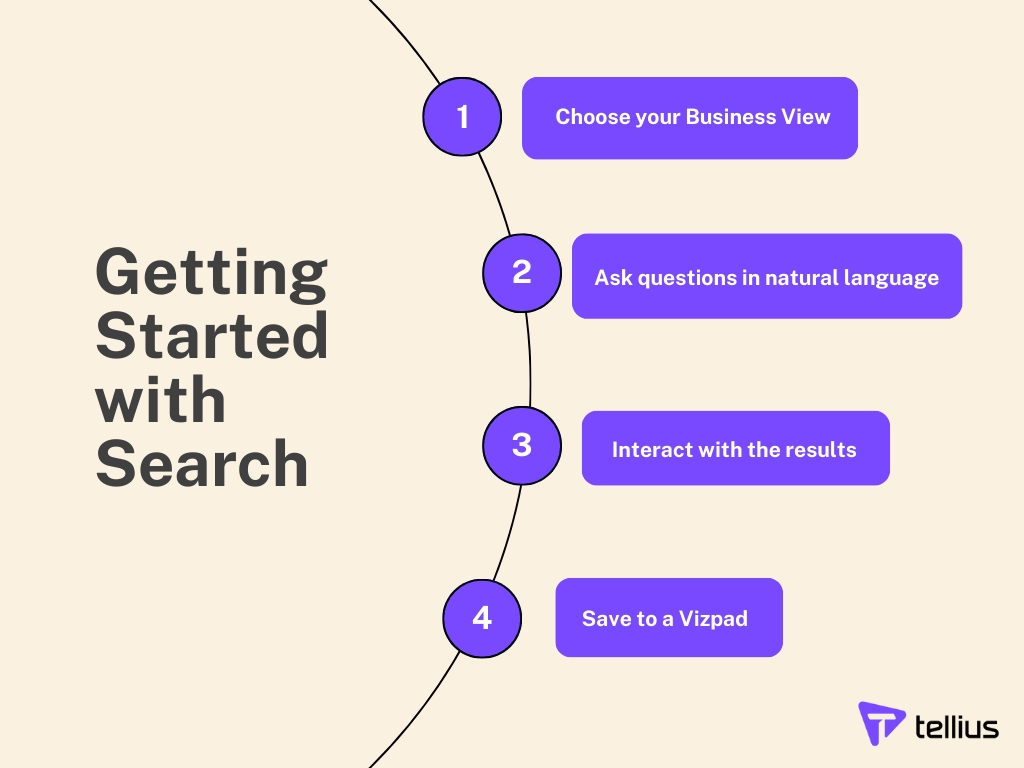Search
Search lets you ask natural-language questions, apply filters, compare periods, analyze trends, and drill into granular data—without SQL or dashboards.
Search offers a smart, Google-like interface that enables users to ask ad-hoc questions and effortlessly drill down to the granular details. Prioritizing user convenience and efficiency, Search eliminates the need for navigating through pre-established dashboards or generating SQL scripts to access data.
Understanding keywords
In your search queries, incorporate the following keywords as required to gain an in-depth analysis of your data.
For filtering data: 'FOR' and 'IN'
'FOR': "Show me sales for 2022"
'IN': "Show me sales in Canada"
For grouping data: 'BY'
'BY': "Show me sales by product category"
For comparing datasets or values: 'COMPARED TO' or 'VS'
'COMPARED TO': "Show me Q1 sales compared to Q2 sales"
'VS': "Show me sales of Product A vs Product B"
For analyzing trends: Specify a date
Specify a date: "Show me sales trend since January 2023"
For analyzing time series: 'BY MONTH' or 'BY WEEK'
'BY MONTH': "Show me sales by month for 2022"
'BY WEEK': "Show me weekly revenue for Q1 of 2023"
For analyzing differences or variations: 'GROWTH' and 'CHANGE'
'GROWTH': "Show me growth in sales from 2022 to 2023"
'CHANGE': "Show me the change in profit from Q1 to Q2 of 2023"
Commonly used keywords and their applications
avg (Average)
To get the average value, such as average sales, use 'avg'. Example: What are the avg sales?
total
For summation, use 'total'. Example: Show me total sales in the US
min (Minimum)
To find the smallest value, use 'min'. Example: What are the min sales in 2022?
max (Maximum)
To determine the highest value, use 'max'. Example: What is the max sales in June 2023?
growth
For monthly growth analysis, use 'growth'. Example: Monthly growth of sales last year
market share
For market share analysis, use 'market share'. Example: Market share of dollar sales for BrandABC
unique count
To count distinct items, use 'unique count'. Example: Unique count of returning_customers
percentage change
To find the percentage change in sales between two periods, phrase your query as follows: Percentage change of sales for this year vs last year
absolute change
To determine the absolute change in sales between two periods, phrase it as: Absolute change of sales for 2020 vs 2021
top/bottom N
To filter by top or bottom performers, use 'top/bottom N'. Example: Show me top 5 products in sales by retailer
contains
To search for a specific substring in your data, use 'contains'. Example: Show me sales for brand contains "fit"
after/before
To filter data after or before a certain date, use 'after/before'. Example: Show me sales after March 2020
between
To filter data between two specific dates, use 'between'. Example: Sales between March 2020 and March 2021
trend
These queries help track changes over time or identify patterns within your data. Example: Show trend of monthly sales for New York vs Los Angeles.
Getting Started with Search

Last updated
Was this helpful?